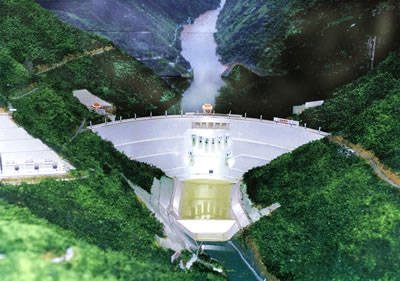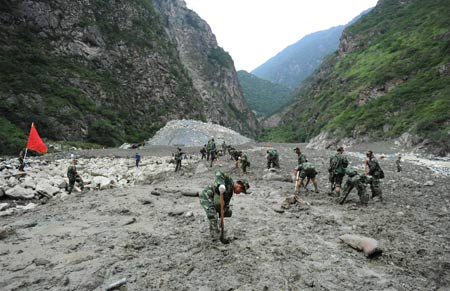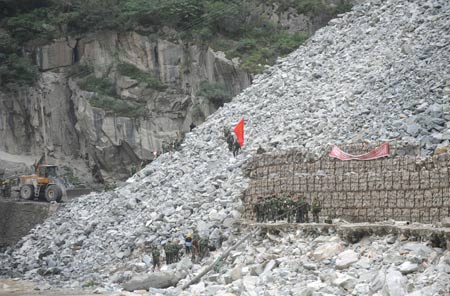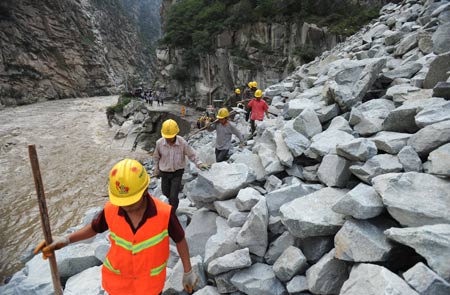26 July 2009
Two recent landslides at hydroelectric sites in China
Posted by Dave Petley
In the past week China has suffered two rather extraordinary landslide accidents at hydroelectric plants.
The first occurred an 20th July 2009 near to the Xiaowan hydroelectric power station in Yunnan province. The dam, shown in the artist’s impression below, will apparently be the world’s tallest arched dam, standing 292 m high when finished. It is still under construction, with the first turbine expected to be operational later this year:

The image above is a bit fanciful as it doesn’t show the lake or the extensive slope works that have been needed. The image below, taken in an earlier phase of construction, gives an idea of the state of the slopes:
 Now interestingly, late last month there was a rather triumphant article in the Chinese media about the second stage filling of the site. The Google translation of the article says this:
Now interestingly, late last month there was a rather triumphant article in the Chinese media about the second stage filling of the site. The Google translation of the article says this:
“It is reported that the second phase of Xiaowan storage power station will be carried out in two steps, 20 July, water power stations will reach 1125 meters elevation; the end of August, water storage, power generation water level will reach 1160 meters elevation, the first unit into operation by the end of September this year power generation is just around the corner” (excuse the rather mangled English).
In other words, the lake level was being elevated for the first time to 1125 m elevation on 20th July. The landslide occurred on that day. The landslide itself was described thus:
“Waves up to 30 metres high swept 14 people into the turbulent upper reaches of the Mekong River following a huge landslide into the river in south-western China’s Yunnan province, state media said on Tuesday. Rescue workers recovered two bodies from the river, which is known as the Lancang in China, and were still searching for 12 others missing since they were swept away in the early hours of Monday, the semi-official China News Service said. An estimated 13 hectares of land plunged into the river near the Xiaowan hydroelectric power station, creating giant waves that engulfed 14 farmers as they camped nearby, the agency said. “
This slide apparently had a surface area of 130,000 square metres and created displacement waves 30 m high. That is a very large landslide!
Then, on 23rd July 2009, another landslide disaster occurred, this time at the site of the Changheba Hydroelectric power (HEP) works in Kangding County, Sichuan Province. It appears that in this case a debris flow hit a construction camp for the dam, which will be a 2.2 GW plant across the Dadu river. Unfortunately, the very large (500,000 cubic metre) debris flow occurred at about the worst possible time, 3 am. It hit a major road and 136 temporary buildings housing workers. It is believed to have killed 57 people. The site of the landslide appears to be shown in this Xinhua image:
 The rescue operations have been hampered by another large failure, this time on the access road to the site. Here it appears that a failure has occurred in a hillside store of boulders that are to be used in the construction of the dam:
The rescue operations have been hampered by another large failure, this time on the access road to the site. Here it appears that a failure has occurred in a hillside store of boulders that are to be used in the construction of the dam:
 The boulders clearly have been generated recently, as this close up image shows:
The boulders clearly have been generated recently, as this close up image shows:
 It appears that they were being retained by gabian walls above the road:
It appears that they were being retained by gabian walls above the road:

The collapse has blocked the highway, meaning that until today heavy machinery could not access the disaster site. This has hampered the rescue operation, although to be honest there seems to be very little chance that there could be any survivors from an event of this size.
If anything, 57 fatalities from 136 temporary houses would seem to be a surprisingly low number.


 Dave Petley is the Vice-Chancellor of the University of Hull in the United Kingdom. His blog provides commentary and analysis of landslide events occurring worldwide, including the landslides themselves, latest research, and conferences and meetings.
Dave Petley is the Vice-Chancellor of the University of Hull in the United Kingdom. His blog provides commentary and analysis of landslide events occurring worldwide, including the landslides themselves, latest research, and conferences and meetings.
[…] long running theme on this blog has been the unacceptably high level of landslides associated with the development of hydroelectric power in Chin…. This was the subject of the paper that I presented at the Vajont conference in 2013; sadly the […]
[…] kind of disaster is all too familiar and highlights the unacceptably high level of landslides associated with the development of hydropower in China and Ind…, Dave Petley, an academic at the University of East Anglia and one of the world’s leading […]
[…] kind of disaster is all too familiar and highlights the unacceptably high level of landslides associated with the development of hydropower in China and Ind…, Dave Petley, an academic at the University of East Anglia and one of the world’s leading […]
[…] kind of disaster is all too familiar and highlights the unacceptably high level of landslides associated with the development of hydropower in China and Ind…, Dave Petley, an academic at the University of East Anglia and one of the world’s leading […]